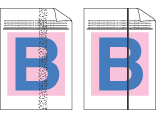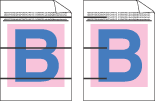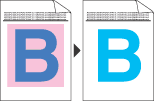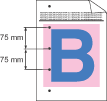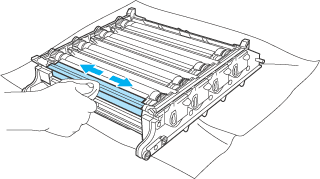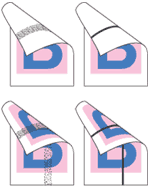White lines or bands or ribbing across the page | | • | Make sure that the machine is on a solid level surface. | | • | | | • | Shake the toner cartridges gently. | | • | | | • | Make sure that you use paper that meets our specifications. A rough surfaced paper or thick print media can cause the problem. (See Acceptable paper and other media.) | | • | | | • | |
|
Colors are light or unclear on the whole page. | | • | Make sure that the recommended paper was used. | | • | Change the paper to freshly unpacked paper. | | • | Make sure that the front cover is closed properly. | | • | Shake the toner cartridges gently. | | • | | | • | |
|
White streaks or bands down the page | | • | Shake the toner cartridges gently. | | • | |
|
Colored streaks or bands down the page | | • | One of the toner cartridges may be damaged. Replace the toner cartridge that matches the color of the streak or bond. | | • | | | • | Make sure each corona wire’s green tab is at the home position (  ). | | • | | | • | The fuser unit may have a smudge mark. Call Brother or your dealer for service. |
|
Colored lines across the page | | • | One of the toner cartridges may be damaged. Replace the toner cartridge that matches the color of the line. | | • | | | • | | | • | |
|
White spots or hollow print | | • | | | • | Make sure that the recommended paper was used. | | • | Choose Thick paper mode in the printer driver or in the machine’s Paper Type menu setting, or use thinner paper than you are currently using. (See Paper type and Basic tab in the Software User’s Guide on the CD-ROM.) | | • | Change the paper to fresh, unopened paper. | | • | Check the machine’s environment. Conditions such as high humidity can cause hollow print. (See Choosing a location.) | | • | | | • | |
|
Completely blank or some colors are missing. | | • | | | • | One of the toner cartridges may be damaged. Identify the missing color and put in a new toner cartridge for the color with the white line. (See Replacing a toner cartridge.) | | • | |
|
Colored spots at 75 mm | | • | Dust, paper powder, glue, and so on may stick to the surface of the photosensitive drum (OPC) and cause black or white spots to appear on printed documents. | | • | | | • | If you still see the spots on printed documents after making multiple copies, clean the drum unit (See Cleaning the drum unit.) | | • | |
|
Toner scatter or toner stain | | • | Check the machine’s environment. Conditions such as high humidity and high temperatures may cause this print quality problem. (See Choosing a location.) | | • | | | • | | | • | |
|
Grey or colored background | | • | | | • | Check the machine’s environment. Conditions such as high temperatures and high humidity can increase the amount of background shading. (See Choosing a location.) | | • | | | • | |
|
Page skewed | | • | Make sure the paper or other print media is loaded properly in the paper tray and that the guides are not too tight or too loose against the paper stack. | | • | Set the paper guides correctly. | | • | The paper tray may be too full. | | • | |
|
Ghost | | • | | | • | Make sure that you choose the correct media type in the printer driver or in the machine’s Paper Type menu setting. (See Acceptable paper and other media and Basic tab in the Software User’s Guide on the CD-ROM.) | | • | |
|
The color of your printouts are not what you expected. | | • | | | • | | | • | | | • | | | • | Perform the calibration by using the control panel.
Press Menu, 4, 6. | 1 | Press OK to select Calibrate. | | 2 | Press 1 to select Yes. (For more information, see Software User’s Guide on the CD-ROM.) |
| | • | Adjust the color by using the custom setting in the printer driver. Colors the machine can print and colors you see on a monitor are different. The machine may not be able to reproduce the colors on your monitor. | | • | | | • | | | • | |
|
All one color | |
Color misregistration | | • | | | • | | | • | | | • | Perform the auto color registration by using the control panel. Press Menu, 4, 7, 1. or | | • | Perform the manual color registration by using the control panel. | 1 | Print the correction chart by using the control panel. Press Menu, 4, 8, 1. | | 2 | Enter the correction value on the chart. Press Menu, 4, 8, 2. |
If the color misregistration is not corrected after registering the color manually, take all the toner cartridges out of the drum unit and turn the drum unit over, then make sure that four drum unit gears are in the home position. The home position of each drum can be identified by matching the number on the drum unit gear to the same number on the side of the drum unit as shown in the illustration. | | • | | | • | | | • | | | • | If solid areas of color or images have cyan, magenta or yellow fringes, you can use the auto-registration feature to correct the problem. |
|
Uneven density appears periodically across the page | | • | | | • | | | • | Make sure that the fuser unit is installed properly. |
|
Missing image at edge | | • | | | • | | | • | One of the toner cartridges may be damaged. Identify the missing color and put in a new toner cartridge for the color with the white line. (See Replacing a toner cartridge.) | | • | |
|
Missing image at thin line | | • | If you are using a Windows® printer driver, open Properties window, and then click Printing Preferences. Choose the Advanced tab, Device Option, Print Setting, and then check the Improve pattern printing or Improve Thin Line boxes. |
|
Wrinkle | | • | | | • | Make sure that the back cover is closed properly. | | • | Make sure that paper is loaded properly. | | • | Make sure that you choose the correct media type in the printer driver or in the machine’s Paper Type menu setting. (See Acceptable paper and other media and Basic tab in the Software User’s Guide on the CD-ROM.) | | • | Turn over the stack of paper in the tray or rotate the paper 180˚ in the input tray. | | • | | | • | Make sure that the fuser unit is installed properly. | | • | If the problem continues, call your Brother dealer. |
|
Insufficient gloss | |
Offset image | | • | Check the machine’s environment. Conditions such as high temperatures and humidity can cause this problem. (See Choosing a location.) | | • | | | • | Make sure that you choose the correct media type in the printer driver or in the machine’s Paper Type menu setting. (See Acceptable paper and other media and Basic tab in the Software User’s Guide on the CD-ROM.) | | • | |
|
Poor fixing | | • | | | • | Make sure that you choose the correct media type in the printer driver or in the machine’s Paper Type menu setting. (See Acceptable paper and other media and Basic tab in the Software User’s Guide on the CD-ROM.) | | • | Make sure that the release lever of the fuser unit is in the closed position. | | • | If the problem continues, call your Brother dealer. |
|
Poor fixing when printed on thick paper | | • | Choose Thick paper mode in the printer driver or in the machine’s Paper Type menu setting. (See Paper type and Basic tab in the Software User’s Guide on the CD-ROM.) | | • | |
|
Curled or wave | | • | Make sure that you choose the correct media type in the printer driver or in the machine’s Paper Type menu setting. (See Acceptable paper and other media and Basic tab in the Software User’s Guide on the CD-ROM.) | | • | Check the paper type and quality. High temperatures and high humidity will cause paper to curl. | | • | If you do not use the machine often, the paper may have been in the paper tray too long. Turn over the stack of paper in the paper tray. Also, fan the paper stack and then rotate the paper 180˚ in the paper tray. | | • | Follow these steps: | 1 | Open the back cover. | | 2 | Push the grey lever to the right as shown below. | | 3 | Close the back cover and re-send the print job.  Note | | When you have finished printing, open the back cover and reset the lever back to the original position. |
|
|
|
Envelope creases | | 1 | Open the back cover. | | 2 | Pull down the two grey levers, one on the left-hand side and one on the right-hand side to the envelope position, as shown in the illustration below. | | 3 | Close the back cover and re-send the print job.  Note | | When you have finished printing, open the back cover and reset the two grey levers back to the original position. |
|
|
White lines or ribbing down the page on duplex print  Note | | Position B is only for duplex printing with recycled paper when the temperature and humidity are low. |
| | • | Choose Plain Paper mode in the printer driver and re-send the print job. If the problem is not solved after printing a few pages, follow these steps: | 1 | Open the back cover. | | 2 | Pull down the two grey levers, one on the left-hand side and one on the right-hand side, to position B as shown in the illustration below. | | 3 | Close the back cover. | | 4 | Choose Plain Paper(Thick) mode in the printer driver and re-send the print job. | | 5 | If the problem is not solved after printing a few pages, choose Thin Paper mode in the printer driver and re-send the print job.  Note | | When you have finished printing, open the back cover and reset the two grey levers back to the original position. |
|
| | • | Use thicker paper than you are now using. |
|
Toner scatter or toner stain on the edge of duplex pages |   CAUTION | | We recommend that you place the drum unit and toner cartridges on a clean, flat surface with a piece of disposable paper underneath them in case you accidentally spill or scatter toner. | | | DO NOT touch the surface of the photosensitive drum. |
Take all the toner cartridges out of the drum unit and turn the drum unit over. Wipe the toner on the edge of drum unit with a dry lint free soft cloth as shown in the illustration. |
Colored streaks or bands down the reverse side of printed pages | |



